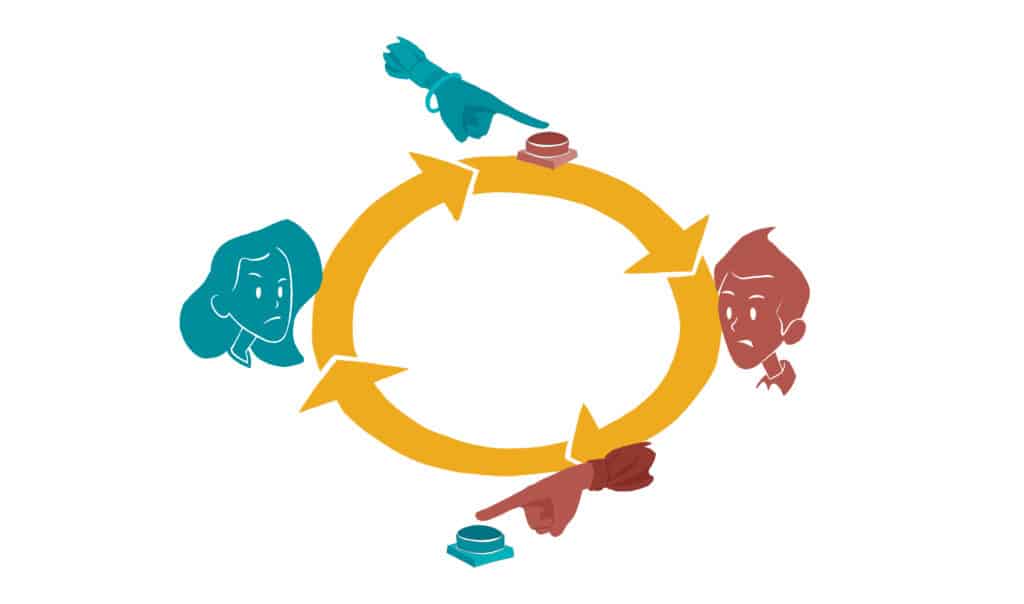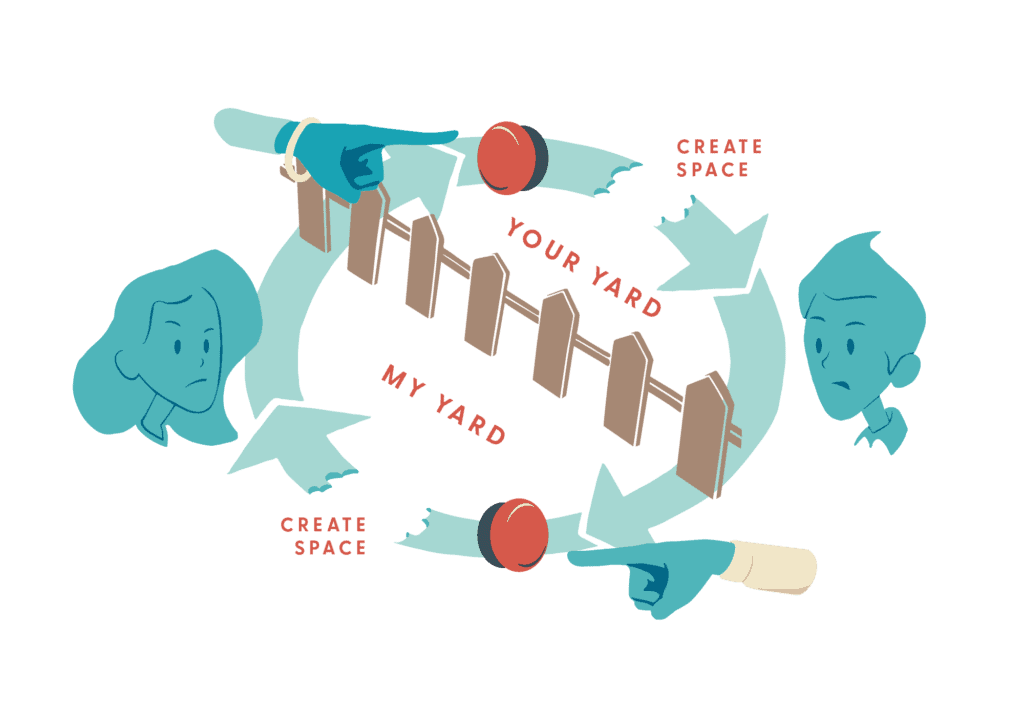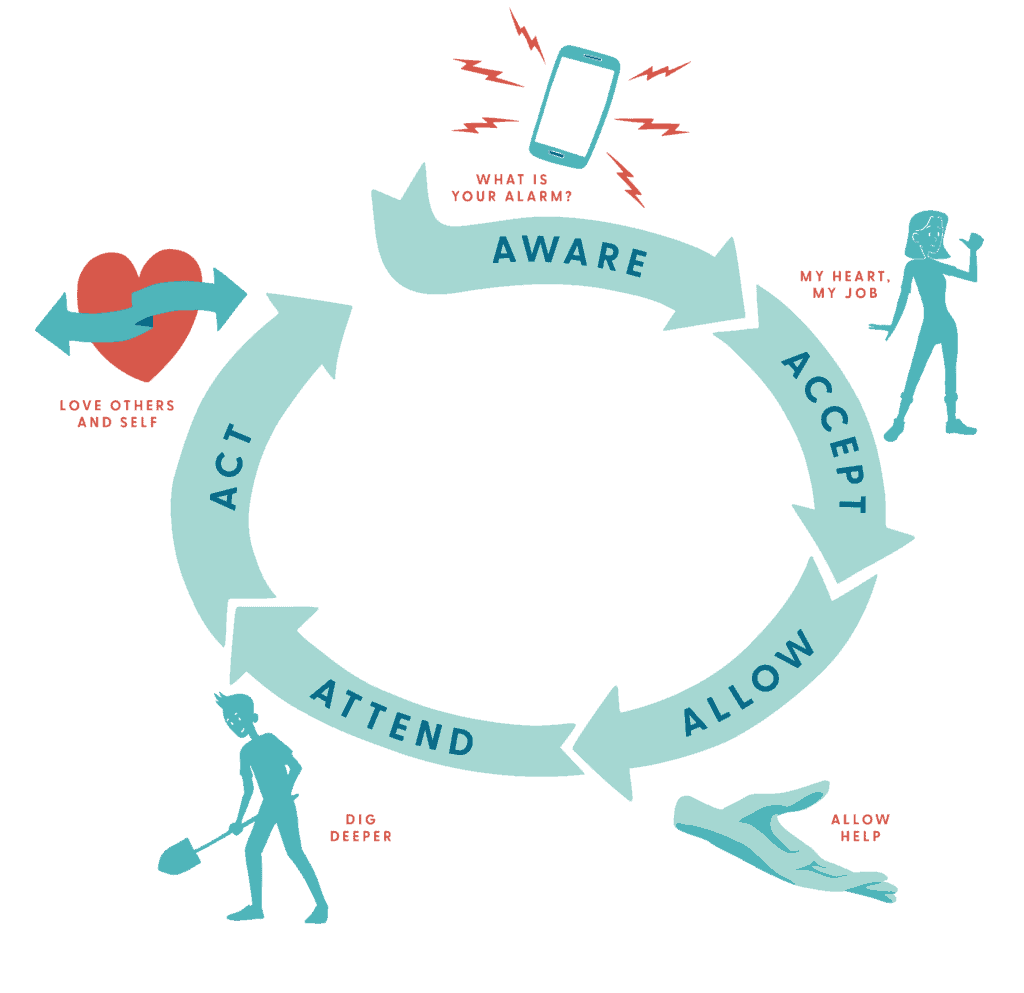Conflict is never about the issue or topic you’re arguing about. Maybe you and your spouse just had a heated discussion over money, sex, the kids, work, or the million other things people fight over … but those things aren’t really what’s at the core of the argument. What’s really happening is that your “buttons” got pushed. Welcome to the Reactive Cycle.
The Reactive Cycle—Dealing with the Deeper Feelings
Obviously, when we talk about people’s “buttons” getting pushed during the Reactive Cycle, we’re not talking about simple feelings like mad, depressed, worried, bored, or tired. When we talk about “buttons,” what we’re referring to are those intense feelings and childhood wounds of which we are often not aware. These hot-button issues are the deeper feelings. Deeper wounds: I am unloved. I‘ve been disrespected. I’m worthless. Abandoned. Inadequate. Unimportant.
Maybe then, a more accurate way to explain what happens when we argue and feel hurt is that our “emotional buttons” got pushed. The Bible says it this way in James 4:1 (NIV): “What causes fights and quarrels among you? Don’t they come from your desires that battle within you?” Your buttons, then, are often the opposite of those unmet desires Scripture describes. For example, if you desire to feel loved, respected, or successful, then the emotional button is the opposite—you feel unloved, disrespected, or failed.
So, remember, it’s not the day-to-day squabbles over money, chores, in-laws, or kids that drive conflict and start the Reactive Cycle. The real issue is the sensitive emotions that get triggered and stirred up. This is what is so misleading about arguments. We’re so focused on the topic (i.e., money) that we miss the underlying root of the conflict—the button that was pushed (i.e., feeling controlled).
Pushed Buttons, Closed Hearts
There’s more to the Reactive Cycle than two people pushing each other’s buttons. When our buttons/emotions are pushed, we don’t just react by pushing the other person’s buttons. We also enter “defense mode” and close our heart to the other person.
This is the key to understanding conflict: When someone’s button(s) are pushed, their heart closes. The only way to move forward is to get the person to re-open their heart.
That’s easier said than done! When my wife Erin and I speak about the Reactive Cycle, we liken a closed heart to a little roly-poly bug. Have you ever seen one? Those gray, armadillo-like bugs roll into a tight ball when they’re touched. It’s a perfect metaphor for what happens during conflict. When your buttons are pushed, you feel emotionally “flicked.” So, your heart shuts down and rolls up in a tight ball. And just like you can’t force open a roly-poly bug without killing it, when your heart—or your spouse’s heart—closes tight, it can’t be pried open. Over time, if a couple continues to practice unhealthy conflict, a closed heart will eventually harden. And this is how unresolved or unhealthy conflict destroys a marriage.
The Reactive Cycle in Action
Here’s the situation: you and your spouse have a disagreement. It escalates. Your spouse then says something that pushes your buttons. You react. The Reactive Cycle starts. It looks something like this:

This is never good! When you’re stirred up emotionally (your buttons are pushed) and your heart is shut down, you’re capable of saying or doing any number of things (reactions). Every reaction will be either a “fight” or a “flight.” (A few people tend to “freeze.”)
The Reactive Cycle: Fighters
“Fighters” directly engage the other person in order to persuade them some say. During their Reactive Cycle, “fighters” will go toe-to-toe with their spouse. They don’t back down or remain silent. They may even follow their spouse around the house while arguing. “Fighters” may get angry, use calm logic, criticize, use sarcasm, yell, throw tantrums, or belittle their spouse—all to make their point. The fighter may even think, “Since we’re not going to connect relationally, I might as well win the argument.”
Fighters jump right into a conflict discussion and advocate for their own opinion, viewpoint, or perspective. They spend the majority of the time in persuasion mode—defending their point of view. The problem with this Reactive Cycle style is that it always sends the same message: I’m not safe for any meaningful interaction with you.
The Reactive Cycle: Flighters
“Flighters” are the opposite of “fighters.” Where fighters actively defend their point of view, “flighters” avoid conflict or withdraw when the conversation becomes difficult. The key trait of a flighter is the reluctance to get into a disagreement (avoidance) or stay with an important conversation (withdrawal). Flighters don’t want to “rock the boat” during the Reactive Cycle, so they’ll “fly below the radar” or “stay out of the fray.”
Withdrawal, on the other hand, may be as obvious as walking out of a room or as subtle as “staying put but logging off” emotionally. A flighter may withdraw by becoming silent or may quickly agree to a solution just to end the discussion with no intention of ever returning to the conversation. It’s not that they don’t talk or interact; instead, they avoid sensitive issues, work hard to minimize conflict, and believe there is little to gain from being upset. A flighter’s motto is, “Relax—problems have a way of working themselves out.”
When flighters are in avoidance mode, you may hear them use the phrase “agree to disagree.” In fact, you may hear this phrase often. What they’re really saying is that they want to avoid conversations that will end in conflict. In essence, a person who chooses flight always sends the same message: I’m disconnecting from any meaningful interaction with you.
Reactive Cycle Styles—Recap
Unhealthy conflict happens when your spouse pushes your buttons, your heart closes, and then you go into reaction mode (fight or flight). In the end, you can’t have a healthy discussion. It’s almost physically impossible! You’re stirred up emotionally, your heart is closed, and you’re reacting. This is why 2 Timothy 2:23 (NIV) warns us, “Don’t have anything to do with foolish and stupid arguments, because you know they produce quarrels.”
Can you see why the Reactive Cycle can harm (or even destroy) your marriage? Nothing good ever comes from this type of unhealthy behavior because it’s the exact opposite of love. Love is patient, kind, content, and humble. Love leads to an open heart. But a closed heart generates negative reactions that drive you and your spouse apart.
The Reactive Cycle—Is There a Better Way?
When it comes to the Reactive Cycle, many people believe—and behave—as if it doesn’t matter how you reach an agreement, as long as you wind up in a good place. We totally reject the idea that “the ends justify the means” because we’ve seen the damage and pain from the many marital battles that “reached a resolution” but destroyed individuals and relationships along the way.
Erin and I believe that how you get from point A to point B is every bit as important as where you end up. We challenge couples to work through differences and deal with conflict to only use methods that are respectful and kind—as if you’re dealing with someone you like (maybe even love!), rather than an enemy. Don’t let marital conflict lead to casualties.
By the way, Erin and I never teach “fair fighting” rules. You fight adversaries. Your spouse is never your enemy! Your spouse is your friend and lover. So, create a “no-fight zone” in your home. Yes, you still have to deal with conflicts and differences, but you can also handle them with tremendous respect and care—as friends would do.
How to Break the Reactive Cycle
Now that you know about the Reactive Cycle, we’ll show you how to break out of it. But before we show you, we want to point out a significant mistake most people make during conflict that keeps the Reactive Cycle spinning.
When their buttons are pushed, most people try to correct their spouse’s behavior or power through the conversation. Both behaviors are bad strategies and complete wastes of time! Here’s why: First, to get your spouse to change his or her behavior, you have to try to get them to react differently. When we do that, our spouse feels manipulated, invalidated, judged, or unloved. What’s worse, if you succeed in manipulating or controlling your spouse’s behavior, you’ve become a manipulative and controlling person. That’s not how God treats us when we use our will poorly.
Second, reacting to your spouse by powering through the conversation when your heart is closed never works. The Reactive Cycle can cause tremendous pain to your spouse, you, and the marriage.
So, what can you do to break the cycle in a righteous, effective way? Where does your responsibility—and power—lie?

Where Your Responsibility and Power Lie
As a fully functioning adult, you are responsible for yourself. So, in the Reactive Cycle, you are responsible for your “yard”—how you feel (your buttons), and what you do (your reactions).
The good news is that this is also where your power lies. We’ve found it only takes one person to stop the Reactive Cycle, and either you or your spouse can do it without the cooperation of the other. It’s exactly what the Bible says in Matthew 7:3-5 (ESV): “Why do you see the speck that is in your brother’s eye, but do not notice the log in your own eye? Or how can you say to your brother, ‘Let me take the speck out of your eye,’ when there is a log in your own eye? You hypocrite, first take the log out of your own eye, and then you will see clearly to take the speck out of your brother’s eye.”
Not only is this amazing advice from Jesus Himself, but it’s also a necessary mindset for breaking out of unhealthy conflict. When applied to marriage, the message becomes this: before you try to have a conversation together and talk through the conflict, you should deal with yourself first. When your spouse pushes your buttons, step back, get your heart open again so that you can respond to your spouse instead of reacting.
Responding (instead of reacting) is a Christlike behavior because the focus is on loving, caring, listening, understanding, validating, and empathizing. As Proverbs 16:23 reminds us, a wise man’s heart guides his mouth. Or, to apply it to the Reactive Cycle, an open heart guides a healthy conversation.
Moving from the Reactive Cycle to an Open Heart
So, you and your spouse have just spun through the Reactive Cycle. And now, you want to take personal responsibility and reopen your heart. Great! But how?
Create space.
What does that mean?
Creating Space
Typically, when Erin and I encourage people to create space, they think we’re talking about increasing the distance from their spouse. While that might be helpful, we’re talking about a different type of space. The space between your button and your reaction. Putting distance between buttons and reactions breaks the Reactive Cycle.
The Reactive Cycle only continues if both people play. It’s similar to a game of Tug-of-War. Two people hold the rope and pull in opposite directions. If one of them drops the rope, the game is over. The same thing happens in the Reactive Cycle. If one of you chooses not to react, the cycle ends.
It’s important to note, though, that as you create space between yourself and your reactions, you need to let your spouse know you’re not walking away from them. Instead, you’re taking a time-out to allow your heart to open again.
For example, you might tell your spouse something like this: “I love you and want to hear you, but right now, I’m pretty shut down and am unable to really listen to you. I’m taking a quick time-out to gather myself, reconnect with God, and allow my heart to reopen. But I will be back to resolve our argument together.” Notice that you’re not asking for your spouse’s permission. Instead, you’re letting them know that you need a break and will be back.
Taking a time-out is not the same as withdrawing. Withdrawal is an unproductive “flight” reaction. And in the long term, withdrawal leads to emotional distance. Calling a time-out is a coping strategy that gives you a chance to reopen your heart and reengage with the conversation in a healthy and respectful way.
The Reactive Cycle: Recap
Buttons are real, and we can’t tell when someone will push them. You can’t erase or do away with your buttons, but you can deal with them in a healthy way by knowing when they are pushed and learning how to keep them from influencing your behavior in a way that hurts the person you love and the relationship you care about.
Stopping the Reactive Cycle is better than continuing in it. But please note that we’re not giving you or your spouse permission to avoid and withdraw. Creating space can stop the madness, but it doesn’t take you or your relationship to a better place. It’s what you do in that space that determines whether you move to a better place.
The Reactive Cycle results in an ineffective and unpleasant interaction between husband and wife. When either breaks that cycle, they interrupt the interaction and temporarily step out of it. Because your power and responsibility lie in your personal space, that’s where your attention needs to go. By taking a time-out, you can now reconnect with God, work toward an open heart and care well for yourself. The time-out can then shift into what we call the Care Cycle.
The Care Cycle vs the Reactive Cycle
The Reactive Cycle is a never-ending spin of buttons and reactions. The Care Cycle, however, is a five-step process that helps you manage your feelings when you’re triggered, hurt, and angry. The tool works no matter your typical reactions.
The Care Cycle also helps you manage all aspects of healthy self-care—taking responsibility for your physical, mental, emotional, and spiritual well-being.

So, the Care Cycle is the one tool you can use whether you’re upset and need help handling your emotions or you’re doing regular proactive self-care maintenance. The goal is to make sure you’re always well-cared for and have an open heart. Unlike the Reactive Cycle, the Care Cycle helps you fully embrace the person God created you to be, to invest the valuable assets entrusted to your care, and to fulfill all he put you here to do—no matter what any person or circumstance throws your way.
The Care Cycle—Five Steps
Ready to swap the Reactive Cycle for the Care Cycle? Let’s get started!
Step 1: Aware
Tune in to signals that alert you to your feelings—the feelings tell you a button just got pushed. Your body sounds the first alarm: your heart rate goes up, you start to sweat, your shoulders tighten from the tension. Listen to these signals so that you realize you’ve been triggered and your heart has closed. Once you’re aware of what’s happening, you can shift from reaction to attention. Something’s going on here that needs my attention!
Step 2: Accept
Acceptance is a two-part process. First, accept the job of caring for yourself. You’re an adult; it’s your responsibility. It’s exactly like Galatians 6:5 (ESV) says, “Each will have to bear his own load.” In the original Greek, the word used here for load refers to “cargo.” It’s a lighter problem you need to carry—like a backpack.
The second part of Acceptance involves welcoming your feelings, even if you don’t understand them or know why they are unpleasant. Feelings are the voice of our heart and part of God’s design. They provide critical information about what’s going on inside. If you ignore your feelings or try to get rid of them, you’ve eliminated that data, and the ability to care for yourself well. So, instead of ignoring the feelings, tell yourself, “OK, this feels terrible, but my body and emotions are talking to me. I need to figure out what’s going on and what I can do to make sure I stay well cared for and maintain an open heart.”
Step 3: Allow
Even though it’s your responsibility to care for yourself, God did not design you to, nor does He expect you to, do it alone. Psalm 55:22 (NLT) confirms this truth: “Give your burdens to the Lord, and he will take care of you. He will not permit the godly to slip and fall.” Prayerfully allow God to help. You’re not asking God to do absolutely everything for you while you simply sit there. You’re asking Him for help as you care for yourself. You are still maintaining responsibility for yourself. But your prayer can sound something like this: “God, I could sure use a hand. Will you help me understand what’s happening in me and what caring for myself will look like? I need extra strength, wisdom, insight, and patience because right now I’m feeling overwhelmed.”
Once you’ve aligned yourself with God, if needed, you can also allow another person to help. Galatians 6:2 (NIV) says, “Carry each other’s burdens.” The Greek word used here for burden means something that is heavy or is too much for one person to bear alone. God created us as communal beings, and we often function in better in supportive teams—friendships, trusted colleagues, or the marriage relationship. In every case, however, remember that as an adult, you must maintain full responsibility for the job of caring for yourself. Other can help “carry your burdens,” but all support people are volunteers—including your spouse!
Step 4: Attend
Now it’s time to go to work. While the first three steps can happen in seconds, this step requires thought and reflection. You’ll need to ask yourself questions so that you can understand what’s happening inside and develop a great self-care strategy. You may want to ask questions like these:
- What am I feeling right now? Why?
- What are these feelings trying to tell me?
- Where is this feeling coming from? Have I felt this way before? When?
- Is this feeling reminding me of something from my past? Something like a trauma or poor choice?
- Am I feeling this because I’m believing something untrue? What is the truth?
- What do I want?
And here’s one of the best questions you can ask yourself: Is there anything I’m doing that is turning up the volume or causing these feelings? The good news is that if you’re causing it, you can change it!
Ask anything you can think of to help you understand what’s going on, where it’s coming from, and what you want or need. Keep in mind that you’re developing a self-care plan, so more information is better.
Once you’ve answered the questions and have a good understanding of what’s happening inside, shift your attention to crafting a self-care plan. The best plans are those you can implement by yourself so that you feel well-cared for and empowered. Your self-care plan can include:
- Steps to make yourself feel better
- How to set good boundaries
- How to talk to someone about a difficult or awkward situation
- What to do if the conversation doesn’t go well
- How to keep God in all of your plans
Step 5: Act
Once you’ve completed the previous steps, care for yourself so that your heart opens again. The best-laid plans only work when they’re fully implemented. Make sure that what you do internally and externally — toward others—is done with complete integrity. That means acting in ways consistent with the person God designed you to be, which will be considerate of those with whom you interact.
Once your heart is open and well-cared for, you are safe to have a God-honoring conversation with your spouse.
The Care Cycle and the Reactive Cycle: Putting It All Together
Now that you understand what’s happening when you and your spouse disagree (The Reactive Cycle), you can work to reopen your heart when your buttons get pushed (The Care Cycle).
I like how my dad, Dr. Gary Smalley, once described this process:
Conflict is inevitable in relationships. It rears its head in even the healthiest, most deeply intimate of marriages. It is how you handle conflict that will determine how it affects your relationship, for better or for worse. Again, the most important aspect is not how much you love each other or how committed you are to your relationship or the strength of your faith; optimum relationships depend on how adeptly you handle conflict. Every instance of conflict represents two divergent paths: you can use it to grow together or grow apart. Open the door. Walk through—and you’ll learn more about the delights of marriage than you ever dreamed possible.
We love this thought: we can use conflict to either grow closer together or further apart. You have the same choice to make. You can use unproductive patterns of dealing with conflict (The Reactive Cycle) or use the Care Cycle to get to the deepest levels of intimacy and connection, to the place the Apostle Paul envisioned. “Let all bitterness and wrath and anger and clamor and slander be put away from you, along with all malice. Be kind to one another, tender-hearted, forgiving each other, just as God in Christ has forgiven you” (Ephesians 4:31-32, ESV).
The Reactive Cycle, or the Care Cycle. The choice is yours!

















